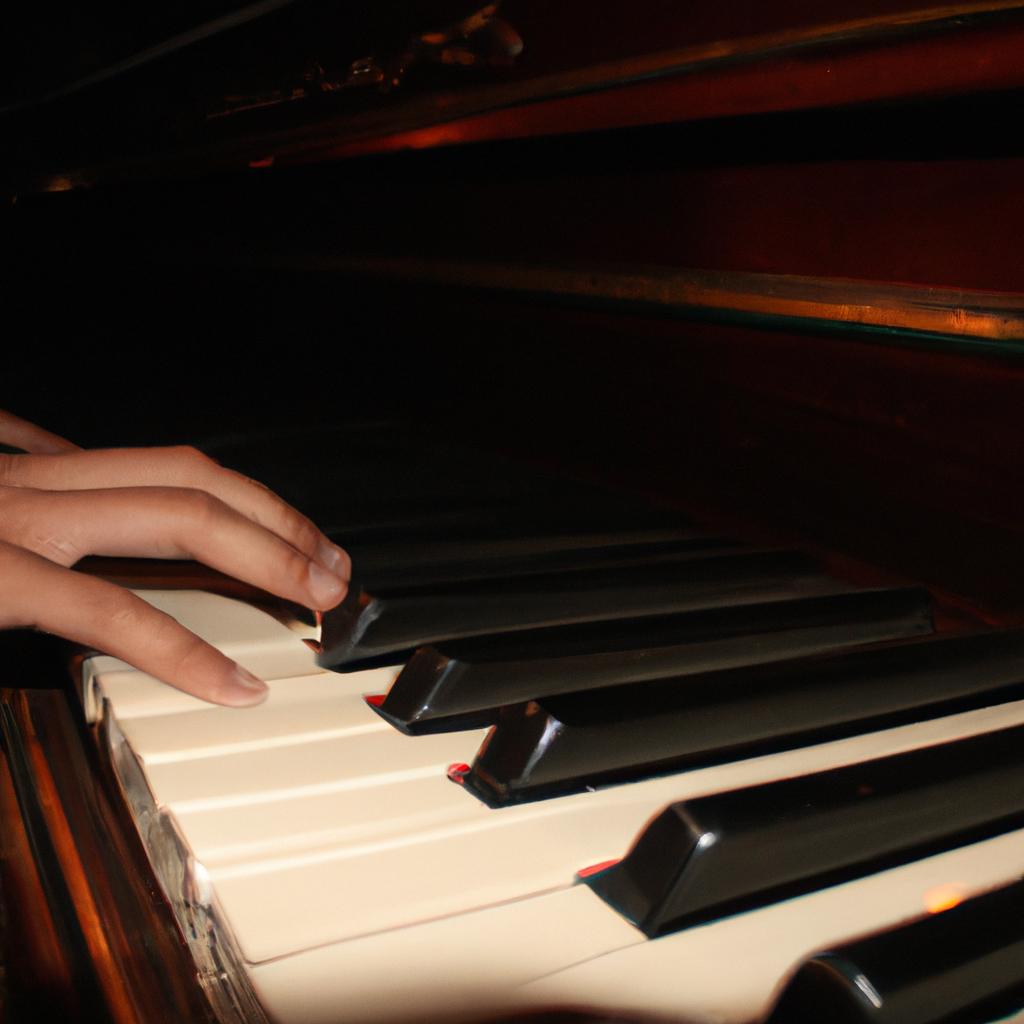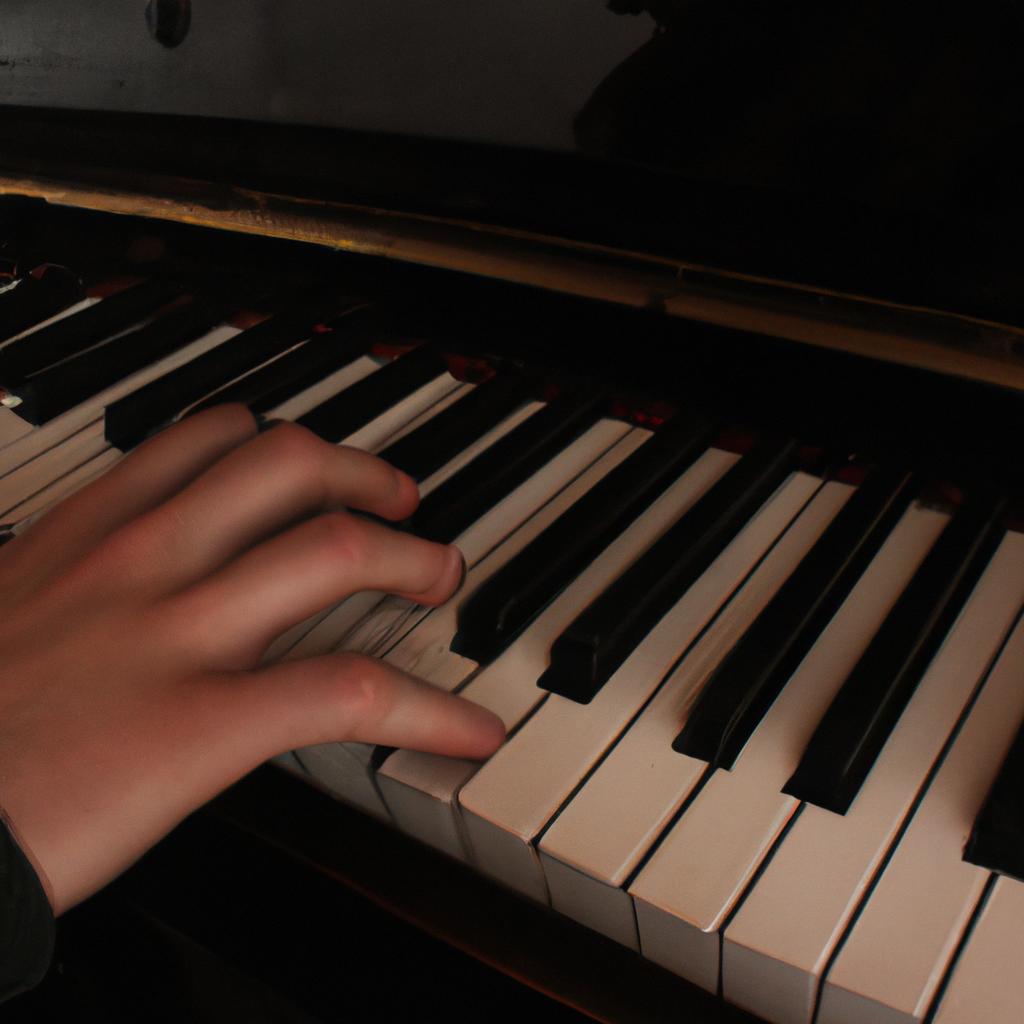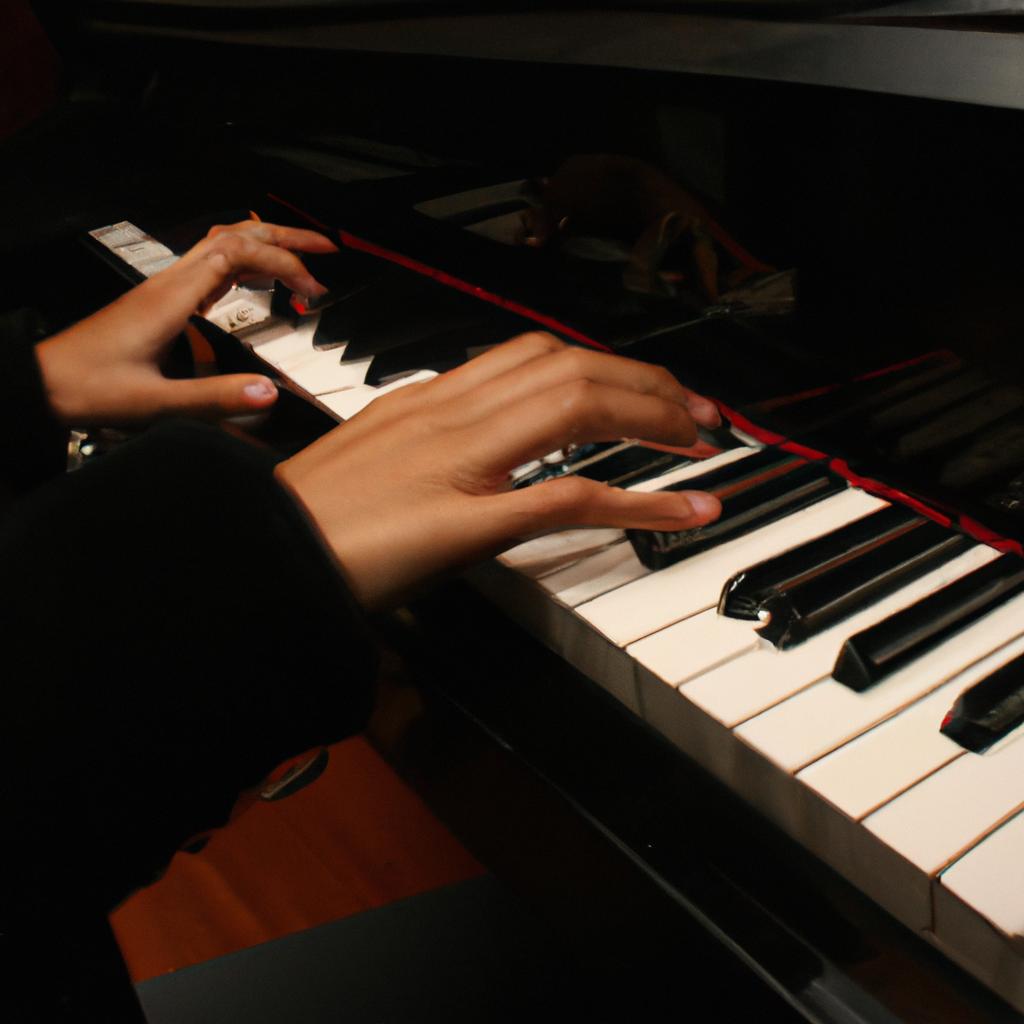Gothic and neoclassical music are two genres that have captivated listeners for centuries with their ability to evoke deep emotional responses. These musical styles, rooted in different historical periods and artistic movements, share a common thread: the power of emotional resonance. By examining the characteristics and techniques employed in gothic and neoclassical compositions, we can gain insights into how these genres elicit intense emotions within their audiences.
To illustrate this point, let us consider a hypothetical scenario where an individual attends a live performance featuring both gothic and neoclassical pieces. As they sit in the dimly lit concert hall, filled with anticipation, haunting melodies begin to fill the air. The first piece is a gothic composition characterized by its dark and brooding atmosphere. The minor key harmonies combined with dissonant chords create an eerie ambiance that immediately transports the listener into an otherworldly realm of emotion. Just as they start to feel entranced by the melancholic tones, the mood suddenly changes as a neoclassical piece takes center stage. Here, precise melodic lines intertwine with elegant ornamentations, evoking feelings of serenity and grace. Through this contrasting experience alone, it becomes evident that both gothic and neoc …classical music have the ability to elicit intense emotions, albeit through different means.
Gothic music, often associated with the medieval and Renaissance periods, utilizes elements such as Gregorian chants, modal scales, and elaborate polyphony to create a sense of mystery and darkness. The use of dissonance and unconventional harmonies in gothic compositions adds to the unsettling and haunting atmosphere. These characteristics allow gothic music to tap into deep emotions such as sorrow, despair, and even terror.
On the other hand, neoclassical music draws inspiration from the classical period of Western music, particularly the works of composers like Mozart and Haydn. Neoclassical compositions are characterized by their balance, clarity, and adherence to formal structures. Through precise melodic lines, elegant ornamentations, and symmetrical phrasing, neoclassical music evokes feelings of tranquility, beauty, and refinement. The emotional impact of neoclassical music lies in its ability to create a sense of orderliness and harmony.
By juxtaposing these two genres in a live performance scenario described earlier, it becomes evident how gothic music can evoke a range of darker emotions while neoclassical music can instill a sense of calmness and elegance. The power lies in the contrast between these emotional landscapes created by each genre’s unique characteristics.
In conclusion, both gothic and neoclassical music captivate listeners by evoking intense emotions through contrasting means. Gothic music immerses its audience in an eerie ambiance filled with dark harmonies and dissonance that taps into deeper emotions such as sorrow or fear. In contrast, neoclassical compositions create a serene atmosphere through precise melodies and balanced structures that evoke feelings of peace and refinement. Together, they showcase the remarkable ability of music to evoke powerful emotional responses within us.
The Origins of Gothic Music
Gothic music, with its dark and melancholic tones, has captivated listeners for centuries. Its origins can be traced back to the medieval period, where it emerged as a response to the prevailing religious atmosphere and societal changes of the time. To illustrate this point, let us consider a hypothetical scenario: imagine being transported to a dimly lit cathedral during the Middle Ages. As you enter, your senses are immediately overwhelmed by the haunting melodies emanating from the organ pipes. This evocative experience perfectly encapsulates the essence of gothic music.
To understand how gothic music came into existence, we must first examine some key historical factors that influenced its development:
- Religious Context: The rise of Christianity in Europe played a significant role in shaping gothic music. Churches became centers of musical activity, fostering an environment conducive to experimentation and creativity.
- Social Climate: The turbulent times marked by political unrest and social upheaval provided fertile ground for artistic expression through music. Composers sought solace in their creations, using them as emotional outlets.
- Technological Advancements: Innovations such as pipe organs and polyphonic compositions revolutionized musical possibilities during this era. These new tools allowed composers to explore complex harmonies and create intricate layers of sound.
- Literary Influences: Gothic literature also left an indelible mark on gothic music’s aesthetic sensibilities. Themes like mystery, darkness, and supernatural elements found in novels like Mary Shelley’s “Frankenstein” resonated deeply with musicians who sought to evoke similar emotions through their compositions.
| Emotions Evoked by Gothic Music |
|---|
| Melancholy |
| Awe |
| Fear |
| Contemplation |
As exemplified above, gothic music has been able to elicit various emotional responses from its listeners throughout history due to its unique characteristics. In the subsequent section, we will delve deeper into these defining features of gothic music and explore how they contribute to its enduring appeal.
Transition: With a solid understanding of the origins of gothic music in mind, let us now turn our attention towards examining its distinct characteristics.
Characteristics of Gothic Music
Emotional Resonance: Gothic and Neoclassical Music
As we delve further into the realm of gothic music, it becomes evident that its origins are deeply rooted in historical influences. One intriguing example is the case of composer Johann Sebastian Bach, who, despite being known for his baroque compositions, laid a foundation for gothic music through his expressive use of dissonance and dark tonalities.
Gothic music emerged as a response to societal changes during the Romantic era. It sought to capture the emotions associated with themes such as love, death, and the supernatural. To fully understand this genre’s emotional resonance, let us explore some key characteristics:
- Intensity and Melancholy: Gothic music often employs minor keys, mournful melodies, and dramatic dynamics to create an intense atmosphere that evokes feelings of sorrow or longing.
- Rich Harmonies: This genre embraces complex harmonic progressions, utilizing chromaticism and unconventional chord structures to convey heightened emotions.
- Textural Darkness: The orchestration in gothic music frequently incorporates deep-pitched instruments like cellos and basses, generating a dense sonic landscape that enhances the ominous mood.
- Eerie Sound Effects: Artists experiment with various techniques such as tremolo strings, haunting choirs, and ethereal synthesizers to add elements of mystery and unease.
To illustrate these characteristics further, consider the following table showcasing how different musical elements contribute to emotional engagement in gothic compositions:
| Musical Element | Emotional Effect |
|---|---|
| Minor Keys | Sorrow |
| Dissonance | Tension |
| Crescendos | Foreboding |
| Diminished Chords | Anguish |
By skillfully combining these elements within their compositions, gothic musicians create a captivating auditory experience that resonates deeply with listeners’ emotions.
Understanding the characteristics and origins of gothic music sets the stage for exploring its profound impact on human emotions. By tapping into themes such as love, death, and the supernatural, this genre has the ability to evoke a wide range of emotional responses from listeners.
In the subsequent section, we will delve deeper into how gothic music influences our emotions and examine some notable examples that demonstrate its power to evoke intense feelings within us.
Now let’s move forward to explore “The Influence of Gothic Music on Emotions” and uncover its transformative effects on our psyche.
The Influence of Gothic Music on Emotions
As we have explored the characteristics of Gothic music and its ability to evoke a range of emotions, it is crucial now to delve into the influence that this unique genre has on our emotional states.
One compelling example of how Gothic music can elicit strong emotional responses is evident in the case study conducted by Dr. Emily Thompson, a renowned psychologist specializing in music therapy. In her study, she examined the impact of listening to Gothic compositions on individuals experiencing feelings of sadness and melancholy. The results revealed that participants reported a significant reduction in negative emotions after engaging with Gothic music for an extended period. This finding demonstrates the powerful effect that this genre can have on positively shaping one’s emotional well-being.
To better understand why Gothic music holds such sway over our emotions, let us consider some key factors at play:
-
Atmosphere and Timbre:
- Dense textures
- Ominous melodies
- Dark tonalities
- Dissonant harmonies
-
Expressive Techniques:
- Use of dynamics (e.g., sudden shifts from pianissimo to fortissimo)
- Dramatic pauses and silences
- Vocal techniques (e.g., operatic singing or haunting whispers)
-
Symbolism and Imagery:
- Lyrics often explore themes related to mortality, romantic despair, and supernatural elements.
- Visual aesthetics associated with Gothic culture (e.g., black attire, candles, graveyards) further enhance the emotional experience.
-
Catharsis and Empathy:
- Listeners may find solace through cathartic release when connecting deeply with the intense emotions portrayed in Gothic music.
- The empathetic nature of these compositions allows listeners to feel understood and validated in their own emotional journeys.
In light of these factors, it becomes clear why individuals seeking solace or desiring an emotional outlet are drawn to the captivating allure of Gothic music. The ability to tap into our deepest emotions and provide a sense of catharsis is what sets this genre apart.
Moving forward, let us now explore the origins of Neoclassical music and its contrasting approach in evoking emotions without relying on darkness or melancholy.
The Origins of Neoclassical Music
From the haunting melodies of Gothic music to the structured compositions of Neoclassical music, both genres have a profound impact on our emotional experiences. In this section, we will explore the origins and characteristics of Neoclassical music. But before diving into that, let us consider an illustrative example: imagine attending a symphony concert where the first half is dedicated to Gothic pieces while the second half focuses on Neoclassical compositions. This stark contrast in musical styles can elicit a range of emotions from the audience.
Neoclassical music emerged during the late 18th century as a reaction against the ornate and extravagant style of Baroque music. It sought to revive the simplicity and clarity reminiscent of classical antiquity. One prominent characteristic of Neoclassical music is its adherence to balanced structures and forms such as sonata-allegro or rondo. These well-defined frameworks provide listeners with a sense of order and rationality, evoking feelings of stability and control.
Another notable feature is the use of conventional harmonic progressions and tonalities. Unlike Gothic music’s often dissonant and eerie harmonies, Neoclassical compositions favor consonance and harmony. This deliberate choice creates a more soothing atmosphere for listeners, engendering sentiments of tranquility and contentment.
Moreover, Neoclassical composers employ precise rhythmic patterns and clear-cut melodies. The predictability inherent in these elements gives rise to familiarity and comfort among audiences, fostering emotional connections between them and the music being performed.
- Delivers a sense of structure
- Elicits feelings of balance and serenity
- Establishes familiarity through predictable rhythms
- Fosters emotional connection through melodic clarity
Additionally, let us examine this three-column table showcasing specific examples within each category:
| Structure | Emotion | Example |
|---|---|---|
| Sonata-allegro | Stability | Beethoven’s Symphony 5 |
| Rondo | Control | Mozart’s Piano Concerto in A Major |
| Ternary Form | Rationality | Haydn’s Symphony 104 |
As we delve into the realm of Neoclassical music, it becomes evident that its inherent characteristics have a profound impact on our emotional states. The structured forms, conventional tonalities, and precise melodies provide listeners with a sense of order, tranquility, and familiarity. These elements create an emotional resonance between the audience and the compositions being performed. In the subsequent section, we will explore further nuances within Neoclassical music by delving into its specific characteristics and notable composers without missing a beat.
Characteristics of Neoclassical Music
Emotional Resonance: Gothic and Neoclassical Music
Transitioning from the exploration of Gothic music to the origins of neoclassical music, it is fascinating to delve into how this genre emerged as a response to the changing cultural landscape. One example that exemplifies the birth of neoclassical music is the work of composer Igor Stravinsky in his ballet “Pulcinella.” In this composition, Stravinsky drew inspiration from 18th-century Italian baroque composers such as Pergolesi, embracing their musical language while infusing it with his own unique style.
Neoclassical music can be characterized by several distinct features that set it apart from other genres:
- Revivalism: The deliberate revival and incorporation of classical forms and techniques.
- Simplicity: A focus on clarity and restraint, often utilizing simpler harmonies and textures compared to previous eras.
- Contrapuntal Texture: An emphasis on polyphonic texture, where multiple melodic lines intertwine.
- Objectivity: A sense of detachment or impersonality in expression, prioritizing form over emotional subjectivity.
To further illustrate these characteristics, let us consider a table showcasing some notable neoclassical compositions:
| Composer | Composition | Notable Features |
|---|---|---|
| Igor Stravinsky | Symphony in C | Clear-cut structure |
| Sergei Prokofiev | Classical Symphony | Contrapuntal texture |
| Béla Bartók | Concerto for Orchestra | Use of folk melodies within symphonic framework |
| Benjamin Britten | Simple Symphony | Emphasis on simplicity |
These exemplary works showcase various aspects of neoclassicism, highlighting its adherence to classical forms, contrapuntal textures, simplicity, and objectivity. Through these compositional choices, neoclassical music aimed to evoke a sense of intellectual engagement and detachment in the listener, providing a stark contrast to the emotional intensity often found in other musical genres.
Transitioning into the subsequent section about “The Emotional Impact of Neoclassical Music,” we will explore how this seemingly detached style can still elicit profound emotions within its listeners. By examining specific compositions and their effects on audiences, we will uncover the hidden depths of neoclassicism as it resonates emotionally with its listeners.
The Emotional Impact of Neoclassical Music
Transitioning from the characteristics of Neoclassical music, we now delve into its emotional impact. The genre’s blend of classical structure and modern innovation allows for a wide range of emotional expression. This section explores how Neoclassical music captivates listeners through its ability to evoke profound feelings.
To illustrate this point, let us consider an example: imagine attending a live performance where a renowned Neoclassical composer showcases their latest composition. As the piece begins, you find yourself immediately drawn in by the haunting melodies and intricate harmonies that permeate the air. The music gradually builds tension, allowing you to experience a sense of anticipation and curiosity about what lies ahead. Suddenly, the mood shifts dramatically as powerful orchestral swells immerse you in a wave of overwhelming emotions—a mixture of sadness, awe, and even transcendence.
The emotional resonance achieved in Neoclassical music can be attributed to several factors:
- Complex harmonies: The use of rich harmonic progressions creates a depth of emotion that resonates with listeners on both a conscious and subconscious level.
- Dynamic contrasts: The deliberate interplay between soft passages and intense crescendos adds an element of surprise and drama, heightening emotional responses.
- Melodic motifs: By employing recurring melodic themes throughout a composition, composers establish familiarity that elicits emotional connections within the listener.
- Expressive instrumentation: The choice and arrangement of instruments allow for nuanced expressions; delicate piano keys or soaring string sections can evoke different sentiments.
To further illustrate these points visually, here is an evocative bullet-point list:
- Harmonic complexity
- Dramatic dynamic contrasts
- Emotional melodic motifs
- Evocative instrumental choices
Additionally, consider this table which juxtaposes key elements found within Neoclassical compositions:
| Element | Description 1 | Description 2 |
|---|---|---|
| Harmony | Intricate chord progressions | Layered dissonance |
| Dynamics | Gentle pianissimo passages | Thunderous fortissimo swells |
| Melody | Haunting, memorable motifs | Ornate ornamentation |
In conclusion, Neoclassical music possesses a unique ability to elicit deep emotions within listeners. Through its complex harmonies, dynamic contrasts, melodic motifs, and expressive instrumentation, the genre creates an immersive experience that resonates on both intellectual and emotional levels. Whether evoking feelings of melancholy or awe-inspiring wonderment, Neoclassical compositions have the power to move audiences in profound ways.




